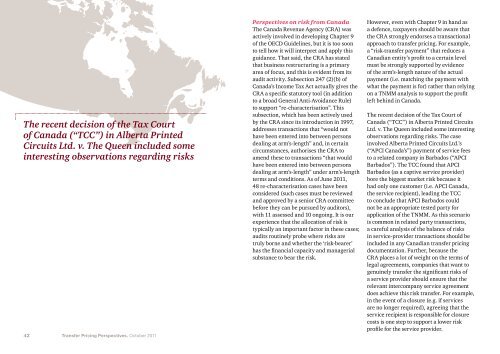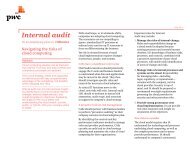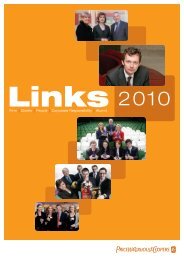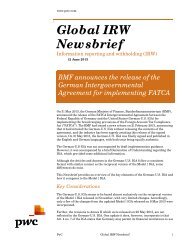The recent decision <strong>of</strong> the Tax Court<strong>of</strong> Canada (“TCC”) in Alberta PrintedCircuits Ltd. v. The Queen included someinteresting observations regarding risks42 <strong>Transfer</strong> Pricing Perspectives. October 2011Perspectives on risk from CanadaThe Canada Revenue Agency (CRA) wasactively involved in developing Chapter 9<strong>of</strong> the OECD Guidelines, but it is too soonto tell how it will interpret and apply thisguidance. That said, the CRA has statedthat business restructuring is a primaryarea <strong>of</strong> focus, and this is evident from itsaudit activity. Subsection 247 (2)(b) <strong>of</strong>Canada’s Income Tax Act actually gives theCRA a specific statutory tool (in additionto a broad General Anti-Avoidance Rule)to support “re‐characterisation”. Thissubsection, which has been actively usedby the CRA since its introduction in 1997,addresses transactions that “would nothave been entered into between personsdealing at arm’s-length” and, in certaincircumstances, authorises the CRA toamend these to transactions “that wouldhave been entered into between personsdealing at arm’s-length” under arm’s-lengthterms and conditions. As <strong>of</strong> June 2011,48 re‐characterisation cases have beenconsidered (such cases must be reviewedand approved by a senior CRA committeebefore they can be pursued by auditors),with 11 assessed and 10 ongoing. It is ourexperience that the allocation <strong>of</strong> risk istypically an important factor in these cases;audits routinely probe where risks aretruly borne and whether the ‘risk-bearer’has the financial capacity and managerialsubstance to bear the risk.However, even with Chapter 9 in hand asa defence, taxpayers should be aware thatthe CRA strongly endorses a transactionalapproach to transfer <strong>pricing</strong>. For example,a “risk-transfer payment” that reduces aCanadian entity’s pr<strong>of</strong>it to a certain levelmust be strongly supported by evidence<strong>of</strong> the arm’s-length nature <strong>of</strong> the actualpayment (i.e. matching the payment withwhat the payment is for) rather than relyingon a TNMM analysis to support the pr<strong>of</strong>itleft behind in Canada.The recent decision <strong>of</strong> the Tax Court <strong>of</strong>Canada (“TCC”) in Alberta Printed CircuitsLtd. v. The Queen included some interestingobservations regarding risks. The caseinvolved Alberta Printed Circuits Ltd.’s(“APCI Canada’s”) payment <strong>of</strong> service feesto a related company in Barbados (“APCIBarbados”). The TCC found that APCIBarbados (as a captive service provider)bore the biggest market risk because ithad only one customer (i.e. APCI Canada,the service recipient), leading the TCCto conclude that APCI Barbados couldnot be an appropriate tested party forapplication <strong>of</strong> the TNMM. As this scenariois common in related party transactions,a careful analysis <strong>of</strong> the balance <strong>of</strong> risksin service-provider transactions should beincluded in any Canadian transfer <strong>pricing</strong>documentation. Further, because theCRA places a lot <strong>of</strong> weight on the terms <strong>of</strong>legal agreements, companies that want togenuinely transfer the significant risks <strong>of</strong>a service provider should ensure that therelevant intercompany service agreementdoes achieve this risk transfer. For example,in the event <strong>of</strong> a closure (e.g. if servicesare no longer required), agreeing that theservice recipient is responsible for closurecosts is one step to support a lower riskpr<strong>of</strong>ile for the service provider.
Perspectives on risk from IndiaThe Indian transfer <strong>pricing</strong> code does notspecifically discuss the circumstancesunder which it may be appropriate forthe Income Tax Department (ITD) tore‐characterise a transaction based ona purported allocation <strong>of</strong> risk that doesnot accord with economic reality. Thecode envisages that the characterisation<strong>of</strong> an entity should be based on thefunctions performed, assets employedand risks assumed by the enterprise.Several Indian rulings 13 have genericallyendorsed the principle <strong>of</strong> aligning theeconomic substance <strong>of</strong> a transaction withits contractual terms, and stated thatthe higher the risks assumed by a party,its expectation <strong>of</strong> returns should also behigher.For the ITD to disregard a transaction,it would have to demonstrate that thetransaction is a sham (lacks substance) or isnot permissible under law. In the absence <strong>of</strong>such a determination, while the ITD couldre‐price the transaction under the transfer<strong>pricing</strong> code, it may not disregard thetransaction altogether. A transaction couldbe viewed as lacking commercial substanceif the purported risk allocation is notconsistent with the functions performed bythe parties, or where risks are allocated toparties that do not have adequate controlover the creation <strong>of</strong> such risks.The following are some examples where theITD has sought to reallocate risks (and theassociated return) in specific situations.In the case <strong>of</strong> an Indian taxpayer thatprovided contract R&D services to a globalMNC (an associated enterprise, the ITDchallenged the mark‐up earned on totaloperating cost. It was alleged that thetaxpayer performed key functions in India(which created R&D risk for the overseasMNC) such as:a. identification <strong>of</strong> products tobe developedb. formulating R&D strategyc. approving the R&D budgetd. decision to abort further R&DThere are also instances <strong>of</strong> high‐pitchedtransfer <strong>pricing</strong> litigation in the Indians<strong>of</strong>tware industry, wherein the disputeappears to be whether the Indian taxpayer(a contract s<strong>of</strong>tware developer) rendereda service or transferred an intangible assetto the overseas associated enterprise. Theissue seems to be the same – whether thecontractual allocation <strong>of</strong> risk between theparties was consistent with their conductand where the significant people functionswere located.An opposite example is seen in regionalprincipal structures, wherein the principal(entrepreneur) entity is located outsideIndia and the Indian affiliate merelyperforms routine manufacturing anddistribution functions relating to thedomestic Indian market. This could createa situation where the entrepreneurialfunctions reside outside India, while theresidual pr<strong>of</strong>its are trapped in India. Attimes, taxpayers have sought to remit suchresidual pr<strong>of</strong>it (after retaining a routinereturn for the Indian manufacturing anddistribution functions) to the overseasentrepreneur through royalties, which aretypically determined through a residualpr<strong>of</strong>it‐split approach. In such cases,tax authorities have not only intenselyscrutinised the royalty payment from atransfer <strong>pricing</strong> and tax characterisationstandpoint, but also sometimes asserted thecreation <strong>of</strong> a Permanent Establishment inIndia <strong>of</strong> the overseas entrepreneur.It may be mentioned that classical principalstructures, which typically envisage twodifferent entities in India performingseparate contract manufacturing anddistribution functions for an overseasentrepreneur, are presently not feasible forregulatory reasons. Under exchange controllaw, an Indian distributor taking delivery<strong>of</strong> goods (belonging to the overseasentrepreneur) from an Indian contractmanufacturer for sale in the Indian market,would not be able to pay the overseasentrepreneur for the goods as there is noimportation into India.AuthorsIan DykesPartner, <strong>PwC</strong> UK+44 121 265 5968ian.dykes@uk.pwc.comElisabeth FinchPartner, <strong>PwC</strong> Canada+1 604 806 7458elisabeth.finch@ca.pwc.comBipin PawarPartner, <strong>PwC</strong> India+ 91 22 66891320bipin.pawar@in.pwc.comLudger WellensPartner, <strong>PwC</strong> Germany+49 211 981‐2237ludger.wellens@de.pwc.comAlpesh ShahDirector, <strong>PwC</strong> UK+44 20 7212 4932alpesh.shah@uk.pwc.comSonia WatsonDirector, <strong>PwC</strong> UK+44 20 7804 2253sonia.watson@uk.pwc.comJustyna DziubaSenior Associate, <strong>PwC</strong> UK+44 20 7213 4847justyna.a.dziuba@uk.pwc.com13Mentor Graphics (Noida) Pvt Ltd v. Dy. Commissioner <strong>of</strong> Income tax (ITA No. 1969/D/2006) and E-Gain Communication Pvt Ltd v. ITO (ITA No. 1685-PN-07).<strong>Transfer</strong> Pricing Perspectives. October 201143
















